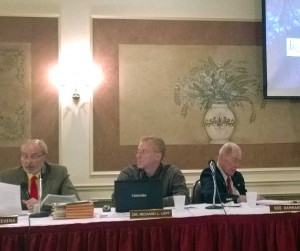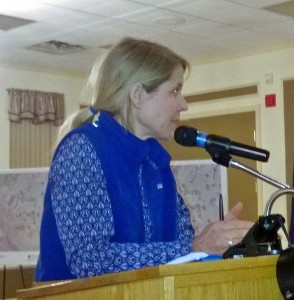Open space advocates face off against Planning Commissioners
By Rick Marts, Staff Writer, The Times

Kennett Township supervisors (from left) Scudder Stevens, Richard Leff and Robert Hammaker listen to public comment on the future of the Chandler Mill Bridge, during a special meeting Wednesday night.
KENNETT — After dozens of witnesses, from engineers to emergency services and school transportation chiefs to nearby residents and Pennsylvania Department of Transportation (PennDOT) project managers, testified in person or in writing, asked questions, and answered them, the dialog that stands out is the impasse between the conservationists and the comprehensive planners about the future of the Chandler Mill Bridge.
This controversy played out clearly before the township’s Board of Supervisors and the nearly 150 attendees at Wednesday’s special meeting to discuss the Chandler Mill Bridge’s future as either a pedestrian-only, pedestrian and vehicle, or vehicle-only bridge with several options for number of lanes and style of rehabilitation.
The board’s purpose in calling the meeting was to discuss bridge rehab costs, repair timing, availability of grants, impacts on safety and open space, the implications of owning or not owning the bridge, and whether road widening would be needed. While most of these and other issues were addressed, none reached the point of closure. Nor could they have been in the span of three hours. This means the supervisors have a long way to go.
Moreover, simultaneous with these discussions and related planning is work being done by the County, the entity that actually owns the bridge, to rehabilitate the bridge as a two-lane structure that will meet state and County standards.

Gwen Lacy of the Land Conservancy of Southern Chester County makes her argument for converting the bridge into a pedestrian-only crossing.
Therefore, it seems to make little sense for the township to trudge on too far until a couple of key questions are answered: Does the township want to own the bridge—it is currently owned by the County, which is willing to give it up—and therefore have responsibility for its maintenance into perpetuity? And which set of goals are to be satisfied, those of the conservationists or those of the land-use planners? Both have laudable objectives and vigorous followings.
After the township’s engineering firm summarized its five options and their costs (this study can be found on the township’s website www.kennett.pa.us.), other key witnesses provided their concerns.
Kennett Fire Chief Steve Melton noted how much time his emergency vehicles now need to reach areas near the bridge. He concluded that without the bridge, it takes a few minutes longer for every route chosen, and often a few minutes can make the difference in the case of a coronary heart attack, for example. And for a quickly spreading fire, a 3- or 4-minute delay can mean saving a home versus a total loss.
Melton said, however, “My primary concern is the time that our ‘mutual aid’ fire companies require to reach this part our township when we need them.” He estimated that without the Chandler Mill Bridge, they need about twice as much time, depending on where they came from.
Tom Jenkins from Kennett Consolidated School District noted that he manages over 600 busses, none of which has been able to use the Chandler Mill Bridge since the mid-1980s. He said, “If we could use the bridge, we would save thousands of dollars in fuel costs every year.”
Gwen Lacy, executive director of the Land Conservancy for Southern Chester County and representing the Southern Chester County Consortium said, “We see only two options: one is a pedestrian/bicycle-only bridge and the other is a one-lane vehicle bridge.”
Lacy noted that many historic sites and venues surround the Chandler Mill Bridge and should be taken into account.
“The bridge is located within the Red Clay Creek Conservation Corridor, which is the largest contiguously preserved area in Kennett Township, with 500 acres to date,” she said. She also noted that “the bridge is part of the 10-mile Red Clay Greenway Trail, a loop trail into and out of Kennett Borough.”
In laying out the benefits of a pedestrian bridge, Lacy said that such a bridge would:
• be less costly to maintain;
• cause adjacent homes to increase in value because of their proximity to a park-like area;
• be more scenic, safe, and historical; and
• provide more access to recreation, reduced noise and pollution, and greater wildlife variety.
Lacy concluded by saying, “It will take courage, foresight, and vision to preserve our quality of life in Kennett Township. It’s more than a bridge, it’s a way of life. The bridge is already used as pedestrian bridge, why not keep it that way.”
After Lacy’s presentation, many residents rose to either agree or disagree with the preferences of the conservation groups that Lacy represents. In particular, two members of the township’s Planning Commission, a group appointed by the BOS, took issue with some of Lacy’s points.
One Commission member, Bob Listerman, said that while the trails mentioned by Lacy are shown in Commission planning documents, they have not been cleared through the Commission for completion.
He said, “The plan is a concept, not an approved action document. Furthermore, the rehabilitation options we’ve seen tonight are not engineered designs, which is what the Planning Commission would need to see before approving their acceptance.”
A second and long-time member of the Commission, John Haedrich, said in a letter to the BOS and read by Chairman Stevens that closing the bridge to vehicles would invalidate all prior comprehensive plans and should not be considered. Haedrich wrote that he is “opposed to creating park-like space for a few residents at the expense of many residents who frequently travel Chandler Mill Road and the bridge.”
Several representatives from the audience made statements or submitted them for the record. They raised complex issues in relation to some of the options outlined by the township’s engineer, especially related to bridge height and the effect of flooding on the connecting roadways.
No decisions were made or votes taken at this meeting.





